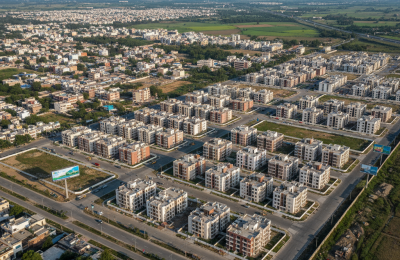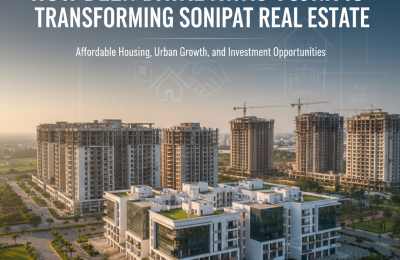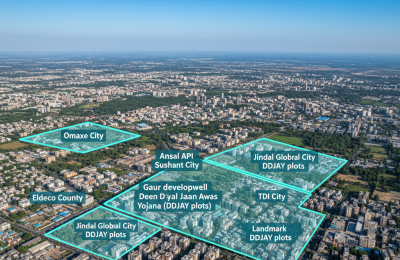A Guide to Plot Appreciation Rates in Sonipat Real Estate Market
The Indian real estate sector has undergone significant growth in the past decade, with emerging cities becoming the new hubs for property investments. One such city that has consistently drawn attention is Sonipat, a rapidly growing district in Haryana, strategically located close to Delhi and part of the National Capital Region (NCR). With infrastructure upgrades, urban expansion, and rising industrial activity, plots in Sonipat have become highly attractive for both investors and end-users.
This guide provides a detailed exploration of plot appreciation rates in the Sonipat real estate market, why the city is becoming a hotspot for buyers, and how investors can maximize returns through well-informed decisions. Whether you are looking for Sonipat property for sale or analyzing long-term Sonipat real estate investment, this article will serve as a complete reference point.
Why Sonipat is Emerging as a Real Estate Hub
Strategic Location and Connectivity
Sonipat is just 45 minutes away from Delhi via NH-44 and is connected to major highways like the Kundli-Manesar-Palwal (KMP) Expressway. The upcoming Delhi-Sonipat Rapid Rail project will further reduce travel time, making Sonipat a prime residential and commercial destination.
Growing Industrial and Educational Infrastructure
Sonipat hosts multiple universities, including O.P. Jindal Global University and Deenbandhu Chhotu Ram University. Additionally, industrial hubs like Kundli and Rai Industrial Area are driving economic growth. This combination of academic and industrial expansion creates steady demand for housing and plots.
Affordable Alternatives to Delhi and Gurgaon
Compared to Delhi and Gurgaon, plots in Sonipat are more affordable, making them ideal for first-time investors. While Gurgaon and Noida have witnessed high saturation, Sonipat offers fresh opportunities for long-term appreciation.
Understanding Plot Appreciation in Sonipat
Appreciation rates in real estate depend on several factors, such as location, infrastructure, market demand, and government initiatives. In Sonipat, these factors are uniquely favorable.
Factors Driving Appreciation of Plots in Sonipat
Infrastructure Development – Highways, expressways, and metro projects directly influence land prices.
Proximity to NCR – Being part of the NCR ensures higher demand from both residents and businesses.
Educational and Industrial Growth – Universities, schools, and factories boost demand for housing.
Government Policies – Initiatives under the Smart City Mission and affordable housing schemes enhance investor confidence.
Migration from Delhi – Increasing property prices in Delhi are pushing buyers to nearby Sonipat.
Current Appreciation Trends in Sonipat Real Estate
Plots in Kundli and Rai
Kundli, being closest to Delhi, has seen plot prices rise by 25–35% in the past five years. Rai Industrial Area also shows similar appreciation due to industrial expansion.
Residential Sectors of Sonipat
Newly developed residential sectors under HUDA (Haryana Urban Development Authority) have shown steady appreciation of 8–12% annually.
Integrated Townships
Projects like TDI City, Parker Residency, and Omaxe City have witnessed consistent growth due to modern amenities and strong infrastructure.
Investment Potential of Plots in Sonipat
When it comes to Sonipat real estate investment, plots provide higher flexibility compared to ready-built properties. Investors can hold them for long-term appreciation or develop them into residential/commercial units.
Key Advantages of Investing in Plots in Sonipat
Affordability – Lower initial investment compared to Gurgaon or Noida.
High ROI Potential – Expected appreciation rates due to infrastructure projects.
Customization – Buyers can design and build homes as per their preferences.
Future Development – Plots near highways and metro corridors are bound to appreciate faster.
Government Role in Boosting Sonipat Real Estate
The Haryana government has introduced multiple initiatives to boost urbanization and real estate in Sonipat:
Expansion of Kundli Industrial Model Township (IMT).
Affordable housing projects under the Deen Dayal Jan Awas Yojna (DDJAY).
Development of logistics parks to attract corporate investment.
Plans for Smart City initiatives focusing on sustainability and urban living.
These policies directly impact the demand and supply balance, further pushing Sonipat property for sale towards steady appreciation.
Best Locations for Plot Investments in Sonipat
Kundli – Fastest growing hub due to proximity to Delhi.
Rai Industrial Area – High demand for employee housing.
Omaxe and TDI Townships – Integrated projects with modern facilities.
HUDA Sectors – Affordable yet promising for long-term investors.
Murthal – Known for food hubs, also gaining real estate traction.
Risks to Consider in Sonipat Real Estate Investment
Like any investment, plots in Sonipat come with risks:
Market Fluctuations – Prices can be influenced by economic conditions.
Delayed Infrastructure Projects – Some appreciation may take time if projects are delayed.
Legal Verification – Buyers must ensure the land title is clear and dispute-free.
Future Outlook of Sonipat Real Estate
Experts suggest that Sonipat will continue to see rising demand over the next decade. The Delhi-Sonipat Rapid Rail, expressways, and industrial expansion are expected to push appreciation rates further. Investors who buy Sonipat property for sale today are likely to benefit from long-term capital gains.
FAQs About Sonipat Real Estate Investment
Q1. Why is Sonipat becoming a popular real estate investment hub?
Sonipat’s proximity to Delhi, infrastructure projects, and industrial growth make it highly attractive.
Q2. What is the average appreciation rate for plots in Sonipat?
On average, plots appreciate by 8–15% annually, with prime locations like Kundli witnessing 25–30% growth in recent years.
Q3. Which areas in Sonipat are best for buying plots?
Kundli, Rai Industrial Area, Murthal, and HUDA sectors are among the top choices.
Q4. Is investing in plots better than flats in Sonipat?
Plots allow higher customization and often provide better appreciation compared to flats.
Q5. What government projects are boosting Sonipat real estate?
Projects include Kundli IMT, KMP Expressway, and Delhi-Sonipat Rapid Rail.
Q6. Are plots in Sonipat affordable compared to Gurgaon and Noida?
Yes, Sonipat plots are 30–40% more affordable while offering similar appreciation potential.
Q7. Is Sonipat real estate investment safe for NRIs?
Yes, provided legal checks are done and investments are made in reputed projects.
Q8. How does Sonipat’s connectivity impact real estate?
NH-44, KMP Expressway, and the upcoming Rapid Rail enhance accessibility, boosting demand.
Q9. Can I expect rental income from investing in Sonipat plots?
Yes, plots developed into homes near industrial hubs provide steady rental income.
Q10. What legal checks are required before buying plots in Sonipat?
Ensure clear land title, RERA registration, and absence of disputes.
Q11. Which developers are leading in Sonipat property for sale?
TDI, Omaxe, Parker, and Ansal API are among the top developers.
Q12. How soon can I expect returns on Sonipat plot investments?
Most investors see good appreciation within 5–7 years, depending on the location.
Q13. Are bank loans available for buying plots in Sonipat?
Yes, most nationalized and private banks provide loans for approved projects.
Q14. How will Delhi-Sonipat Rapid Rail impact real estate?
It will drastically reduce travel time, causing a spike in property demand and appreciation.
Q15. Is Sonipat suitable for both end-users and investors?
Absolutely. End-users benefit from affordable housing options, while investors enjoy strong ROI prospects.
The Sonipat real estate market is one of the most promising in the NCR region. With a blend of strategic location, infrastructural upgrades, industrial growth, and government initiatives, plots in Sonipat are witnessing steady appreciation. For investors seeking long-term gains, Sonipat property for sale offers an excellent opportunity with relatively low entry costs and high future value.
As Delhi and Gurgaon continue to saturate, Sonipat stands out as the next growth hub. By making informed choices, investors can maximize their returns and secure a strong foothold in this evolving market.




